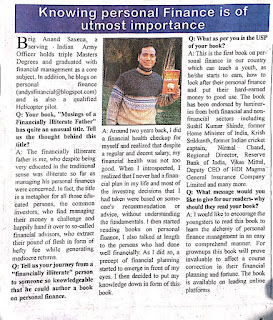PERSONAL FINANCE MUSING 25 VALUE AVERAGING INVESTMENT PLAN (VIP) THE NUTS AND BOLTS
PERSONAL FINANCE MUSING 25
VALUE AVERAGING INVESTMENT PLAN (VIP)
THE NUTS AND BOLTS
My book, “Musings of a (financially) illiterate father- a common investor’s guide to wealth creation and retention is scaling new heights every day besides generating a buzz and having great sales. The book is now available in e-format too on Kindle, Kobo, i-books, and Google.
I will urge you to continue to share this post too as my book has been specially written to teach the alchemy of wealth creation and retention to our children-they deserve to learn it. Please support this mission of financial literacy by reading and recommending this book. The link is given below.
For a debut author writing on the subject of personal finance, so far removed from his core competence area, there cannot be a greater satisfaction than the book being lauded by noted financial experts.
Vikas Mittal, an alumnus of Institute of Chartered Accountants, is the Deputy Chief Executive Officer at Magma HDI General Insurance Co Ltd. He has nearly three decades of experience and is well respected for his financial acumen. He has earlier worked with ICICI Bank, ABN AMRO Bank, Citigroup Wealth Advisors and Magma Fincorp Ltd dealing in banking and finance – retail banking, wealth management, lending and general insurance. Besides, his experience spans institutional and retail equity brokerage. With such diverse and rich experience, he is rightly considered as the last word on matters financial. He was gracious enough to peruse the book, “Musings of a (financially) Illiterate Father” and had the following to say.
“This book is not only a collection of everyday personal finance concepts but more importantly, attempts at bridging the chasm between understanding and action. The book takes a very practical look at the management of personal finances, delivered through a conversational style, which can be used as a primer by a person in any age group, let alone young adults. I remember my early financial decisions being contoured by a simple one-hour conversation with my favorite uncle- 26 years back!
This is not a book which should be read at one go – take time to relish the thoughts, let the ideas swirl around in your mind, absorb the ideas as if for the first time, and I can assure you, it will lead to taking prudent decisions and actions.
The deep research of the author is clearly visible in the book as also his passion to impart the alchemy of wealth creation. I wish Anand Saxena all the best for the success of his book which will be the success of precepts of common sense investing-the underlying theme of this wonderful book.”
Thank you so much, Vikas. I am indeed grateful for your kind words.
This week we continue our discussion on investment strategies for a common investor who is generally able to invest on a monthly basis and yet seeks to maximize returns while minimizing volatility. In the last two posts, we discussed two strategies namely SIP and VIP including an illustrative example of their comparison over one year period. I am providing the links below for continuity.
I must confess this was one series of posts which invited the maximum comments and observations from our astute readers. Many felt that the strategy was impractical and inferior to SIP. I would very humbly like to put across that the investment basket of a common investor must contain all major asset classes and within equity itself, adequate diversification must be maintained. So far as VIP being inferior to SIP, the jury is still out but empirically, over a long period of time (maybe more than 5 years) VIP definitely gives better returns. The second issue is of the practicability of its application for a common investor, I will concede that as of now only Portfolio Management Services (PMS), offer this strategy. However, there is a way for a common investor to benefit from VIP- by following the Exchange Traded Funds (ETF) route.
We will leave the discussion on ETF as an investment vehicle for another day but suffice to say that ETFs are nothing but mutual funds which are traded on the stock markets like common stocks. One needs to have a Demat account to trade in ETFs which most of our readers would be having. If not, please open one on coming Monday itself.
All the Demat service providers give the option of investing in ETFs as e-SIP where one can invest daily, weekly or monthly. The investment can be defined either as quantity (of ETF units) or amount. The current price of ETF is displayed in real time as you make the purchase- manually or automatically as per the given mandate. In the methodology being suggested here, I am recommending a manual purchase model. You would recount the table of investment pattern in VIP from last week’s post- I am reproducing it below.
|
|
|
SIP
|
VIP
|
|||||
|
Quarter
|
NAV
|
SIP Amount
|
Units Purchased
|
Total Units
|
Investment Target
|
Units Purchased
|
Total Units
|
Actual Investment
|
|
1
|
100
|
10000
|
100
|
100
|
10000
|
100
|
100
|
10000
|
|
2
|
125
|
10000
|
80
|
180
|
20000
|
60
|
160
|
7500
|
|
3
|
80
|
10000
|
125
|
305
|
30000
|
215
|
375
|
17200
|
|
4
|
100
|
10000
|
100
|
405
|
40000
|
25
|
400
|
2500
|
So to execute VIP strategy all you have to do is involve yourself once in a quarter and just buy the required number of units (simple calculation on excel sheet or calculator- methodology has been explained in last week’s post). Even if one wants to invest monthly, it is the only couple of minute’s job in a month. If that feels too much again have a look at the table below to see what results you would achieve for this additional work- up to 1.5 to 2.5% CAGR over a 5 year period[1].
|
|
Average Cost
|
Total Cost
|
Current Value
|
Current Gain
|
|
SIP
|
98.76
|
40000
|
40500
|
500
|
|
VIP
|
93.00
|
37200
|
40000
|
2800
|
The second concern may be of the charges one would incur when executing this strategy of VIP by ETF route. Regular plans of mutual funds charge up to 2.5% of NAV as Total Expense Ratio (TER) which is the mandated upper limit by SEBI. The charges for Index ETFs (the ones I am recommending- tracking Sensex or Nifty) have charges between 0.5% and 1% only. The low charges of the ETFs are the reason that the government has allowed Employee Provident Fund Organization (EPFO) to invest up to 15% of the corpus in ETFs. So what is safe and cheap for the government should be good for a common investor as well. Also, my recommending strategy is “buy and hold” so what you buy is to be held for long-term (at least 5 years) to minimize transaction charges and Short Term Capital Gains.
The VIP strategy is, however, not without its drawbacks which are as under.
SIP scores over VIP in simplicity- the investor need not check his/her account for months altogether as the investment is in automatic mode. Secondly, the required amounts to partake the advantage of VIP strategy can grow very large as the corpus increases. If we look at the first table above, in the third quarter the requirement is of Rs 17,200 whereas in SIP it was only Rs 10,000 (fixed amount). Hence a sizeable cash reserve may be required. Keeping a suitable reserve in a liquid fund may be the answer. Thirdly, the VIP strategy will bear fruits over longer periods, between 5 and 10 years.
As my readers would know the aim of my blog is only to spread financial awareness (which I too lacked till some time back) so any discussion on these posts is to stimulate your mind and entice you to read further. SIP, VIP or indeed any investment strategy will prove to be a winner if you select the instrument prudently and invest with a long-term, goal-based time horizon.
My book (paperback) is currently available domestically on Amazon.in, Flipkart, Infibeam and Notion press, and internationally on Amazon.com and Amazon.co.uk. The e-Book version is available on Kindle, Kobo, i-books and Google Books.
For now, enjoy your Sunday while reading my book- you have earned it.



Comments
Post a Comment